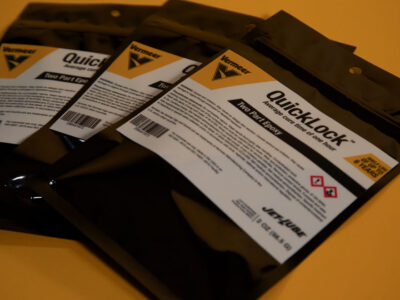Replacing the sub saver on a horizontal directional drill (HDD) when the threads become worn helps maximize the life of the drill rod and helps reduce damage to the drive chuck. Since the sub saver touches every drill rod in the HDD basket, it can potentially damage threads on each one of them. Therefore, its condition should be closely monitored and it should be changed out as part of regular horizontal drilling maintenance.
Thread-locking compound used to properly stabilize the threads between the sub saver and the drive chuck has traditionally made timely replacement of the sub saver challenging. The standard 24-hour cure time for traditional thread lock compounds means you have to plan ahead.
Vermeer Cutting Edge Product Manager Cody Mecham explained, “HDD crews often choose to wait until the end of the shift to replace a worn-out drill sub saver because of the time it takes traditional thread-locking compounds to cure.”
With traditional compounds, crews have few options when the sub saver needs to be replaced. When possible, it’s a good idea to replace it before a weekend or when the drill will not be in use for a full day. Or crews may attempt to speed the thread lock curing process by applying heat.
Shortcuts taken to get around the cure time required of traditional thread lock compounds can have measurable impacts on component life. Delaying the sub saver switch can accelerate wear on threaded connections, while using excessive heat to speed curing time can damage the drive chuck on which the sub saver is mounted.

Faster cure time helps minimize downtime
Vermeer identified a solution to address long thread lock cure times affecting HDD maintenance. Vermeer QuickLock™ two-part epoxy thread-locking compound cures in about an hour, giving crews more flexibility to perform timely sub saver changeouts.
With its extended shelf life and quick cure time compared to more traditional compounds, Vermeer QuickLock™ two-part epoxy thread-locking compound helps you maintain the threaded connection between the drive chuck and the sub saver of your HDD. It’s an efficient and durable option for threaded tooling connections that require a strong permanent bond that adheres to most surfaces and is resistant to acids, solvents and water.
“With Vermeer QuickLock epoxy, crews can replace the sub saver, go to lunch and get back to drilling. This not only helps crews work efficiently, but can help prevent thread damage to drill rods because worn sub savers are being replaced sooner,” said Mecham.
Determine the ideal time to replace the sub saver
Good horizontal directional drilling maintenance includes keeping a close eye on the sub saver. Jagged edges or rounded thread profiles indicate that it’s time to swap out sub savers. But don’t just trust your eyes to determine the condition of threads. Use thread profile gauges to accurately assess the sub saver’s condition. The thread gauges line up with the threads on the sub saver and drill rod to help you identify wear. If there are gaps between the thread gauge and the threads of the sub saver, it is time to change it out.
The replacement process
Thread lock is used between the sub saver and the drive chuck to properly stabilize the threads and help prevent back off. Applying heat to the threads between the sub saver and the chuck will help break the connection. It’s important to only focus heat on the thread area where the locking compound was used. The drive chuck is a heat-treated component, so applying heat to all of it could cause damage.
After the sub saver is removed, make sure the threads on the drive chuck are clean and in good shape before installing the new sub saver. When it’s time to install the new sub saver, thread lock must be applied to the threads between the sub saver and drive chuck.
Vermeer QuickLock thread locking compound comes in a 2.3-oz (65.2-g) double-section plastic pack that keeps the resin and catalyst separate. It can be quickly mixed within the pack before applying to the threaded joint. One pack will coat one 13-3/8 in (339.7 mm) connection with minimal waste.
Once the thread lock is applied to the drive chuck, properly torque the sub saver connection.
Be prepared
Having a spare sub saver and a supply of thread-lock compound can help you optimize HDD maintenance. Thread-lock compounds typically have a six-month shelf life, which can make ordering in bulk to have a convenient supply a challenge.
Vermeer QuickLock has a shelf life of up to six years. This allows inventory to be stocked without excessive concern about expiration dates. Having a spare sub saver and access to thread lock helps crews perform sub changes on a more timely basis.
“The extended shelf life and quick cure time make it simple for crews to maintain the sub saver and maximize the life of their drill rod threads,” said Mecham. “It’s an economic and durable option for threaded tooling connections that require a strong permanent bond.”
The drill rod can be an expensive investment on a directional drill. Maintaining and replacement of the sub saver will help protect that investment. Vermeer QuickLock epoxy helps make more timely replacement possible. For more information on HDD tooling solutions, reach out to your local Vermeer dealer.
Vermeer Corporation reserves the right to make changes in engineering, design and specifications; add improvements; or discontinue manufacturing at any time without notice or obligation. Equipment shown is for illustrative purposes only and may display optional accessories or components specific to their global region.
Please contact your local Vermeer dealer for more information on machine specifications. Vermeer, the Vermeer logo and QuickLock are trademarks of Vermeer Manufacturing Company in the U.S. and/or other countries. © 2023 Vermeer Corporation. All Rights Reserved.
